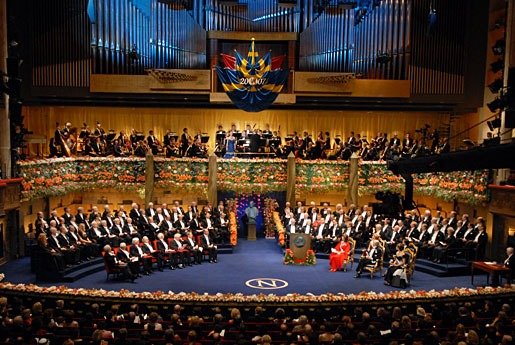1983
Submanyan Chandrasekhar received the Prize for his research “on the structure and evolution of stars”. His work helped us understand how stars age and die. Chandrasekhar calculated what we now call Chandrasekhar limit, which is equal to 1.4 Solar mass. Chandrasekhar showed that if the dying star has a mass of 1.4 Solar mass or less when it reaches the white dwarf stage, it stays a white dwarf forever. A heavier star will continue collapsing and eventually turn into a neutron star or a black hole. You can find more information about Chandrasekhar and his research in our post.
1993
Russell Hulse and Joseph Taylor Jr. received the Nobel Prize “for the discovery of a new type of pulsar, a discovery that has opened up new possibilities for the study of gravitation”.
Back in 1974 American Astronomers Taylor and his graduate student Hulse worked at the Arecibo Radio Telescope. While scanning the sky in search of pulsars, the scientists discovered a fast rotating pulsar. But there was something strange about that object. Its pulses were not evenly spaced and the variations in pulses timing followed a pattern. We see this kind of behavior in binary systems, where the two stars orbit around the point in between them – their common centre of mass. Hulse and Taylor realized that what they observed was not a single pulsar, but a component of a binary system. We now call it Hulse-Taylor binary. It was the first observation of a pulsar in the binary system. Moreover, the second star also turned out to be a neutron star! Taylor carefully studied the system for the next 15 years and noticed that its orbit has decayed! The General theory of relativity predicts that two orbiting bodies should emit gravitational waves. These waves carry away energy and momentum, therefore the orbit decays over time. The rate of the decay observed by Taylor was in good agreement with the theory. It was the first evidence of the existence of gravitational waves!
2002
Raymond Davis Jr. and Masatoshi Koshiba received one half of the Prize “for the detection of cosmic neutrinos”. Riccardo Giacconi received another half “for the pioneering contributions to Astrophysics, which have led to the discovery of cosmic X-ray sources”.
Ray Davis was an American astrophysicist and a chief designer of the Davis experiment (also known as Homestake experiment). Back in 1967 Bethe received the Nobel prize for the explanation how stars make their energy via nuclear fusion. He showed that when a pair of hydrogen nuclei collides, the reaction creates (among other things) an interesting particle called neutrino. Neutrinos are (as the name suggests) electrically neutral and have an extremely small mass. Therefore they fly freely through space without interacting with the matter. The downside? They are hard to detect.
In the late 60s Davis designed the experiment to catch and count neutrinos coming from the Sun. He captured neutrinos in the tank of dry-cleaning fluid installed underground in the old mine. Surprisingly, the amount of neutrinos detected by the experiment was about three times lower that the theoretically predicted.
Koshiba, inspired by the work of Davis, performed a similar experiment in Japan in the 80s. His results were in conclusion with the the results of Davis. More than a half of neutrinos were missing. Almost 20 years later, after repeating the experiment with the better equipment, Koshiba finally solved the mystery of the missing neutrino. Turned out there are 3 types of neutrino, and a type of neutrino can change while the particle flies from the Sun to the Earth! But Davis’s experiment was designed to detect only one type of neutrino!
2006
John C. Mather and George F. Smoot received a Nobel Prize “for the discovery of the blackbody form and anisotropy of the cosmic microwave background radiation”.
After the Cosmic Microwave Background Radiation (CMB) was first discovered by Wilson and Penzias, there were lots of unanswered questions. Many scientists pointed out that if there are fluctuations in density of the matter (it is not uniformly scattered across the Universe but concentrated in galaxies), there should be fluctuations in the CMB as well, or, in scientific words, that the CMB should be anisotropic!
In 1989 COBE (Cosmic Background Explorer) satellite was launched into Space. It’s goal was to carefully measure and map the CMB. The two American cosmologists, Mather and Smoot, were the leading scientists of the COBE project. During its four years in Space, COBE detected the very small but extremely significant fluctuations of the temperature of the background radiation. Those fluctuations are the footprints of the variations in the matter density of the Early Universe!
2011
Saul Perlmutter, Brian P. Schmidt and Adam G. Riess received the Prize “for the discovery of the accelerated expansion of the Universe through observations of distant supernovae”.
Everything started with the Big Bang and we live in the expanding Universe, we all know that. But after the initial BOOM one would expect the things to slow down a bit!
But the two independent teams of scientists, the first one led by astronomers Schmidt and Riess and the other one by Perlmutter, came to the same conclusion: our Universe is accelerating, and the rate of this acceleration is increasing. Sounds scary!
What astronomical discovery will be next to receive the highest award?
Do you have your favourite (or most inspiring or even hard-to-believe-in) astronomical discovery? Let our mobile planetarium know!


